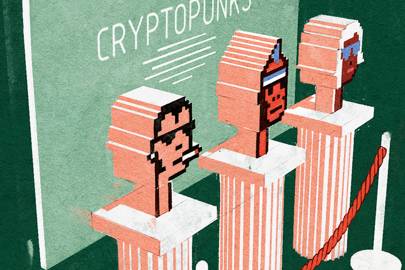
Lockdown significantly increased the number of hours people spend online. In the UK, the communications regulator Ofcom’s annual Online Nation report revealed that, in April 2020, UK adults spent on average four hours online every day, compared with 3.5 hours in September 2019. This has created opportunities for digital-content innovators and, in 2021, they’ll have a new way to earn money for their products.
Selling digital assets such as avatar skins isn’t new, but there was no way to prevent the replication of those assets by other users. In 2021, we will see a new type of decentralised digital asset called a Non-Fungible Token (NFT). Use cases for NFTs are already being created by decentralised gaming platforms such as Decentraland, Cryptovoxels and Somnium Space.
In economics, non-fungibility means that an item is unique, like an original work of art or a restaurant meal. Fungible items are those that are interchangeable with identical goods – such as gold or tins of beans. NFTs are the product of a technology protocol, published on the Ethereum blockchain in September 2017, that allows for the creation of certifiably singular digital assets. Each NFT is tied to a different identifier, making each token non-fungible and unique to its owner. A developer can create a contract where every token holds a different value, so someone can create a digital asset they can prove is theirs, and sell it for real money.
The case for NFTs has been growing since June 2017, when the launch of CryptoPunks – in which people can buy one of 10,000 unique characters – paved the way for “rare” art on the Ethereum blockchain. In October that year, DADA.Art launched the first marketplace for rare digital art. And In 2018, kitten illustrations on Ethereum-based games such as CryptoKitties were selling for up to $160,000. Now the market is expanding, with users gravitating towards complex assets such as tickets to events and even ownership records for physical assets, for example, shares of an artwork or collectible item.
The majority are virtual credits for virtual use, such as a weapon for a game, but the real opportunity for NFTs exists where the virtual worlds and analogue worlds converge. 2021 will see the launch of a spate of mixed-reality hardware products and applications, including the next generation of AR glassware. Mixed-reality NFTs will be at the core of our experiences in this area, from filters, art and game assets, to virtual pets that can interact with the real world, to financial securities and proprietary data streams (such as selling access to your FitBit data).
They will allow NFT creators to prosper in a major way. According to nonfungible.com, which monitors the crypto-collectable market, in July 2020, total NFT sales surpassed $100m. In 2021, that number will be boosted by increased penetration of NFTs into the mainstream. Major brands are already creating and trading NFTs: Nike has used them to create digital shoes that are linked to real-world shoes; Formula 1 has developed a racing and collectables trading game; Louis Vuitton uses NFTs to track the provenance of luxury goods; and Samsung has created an NFT-supported cryptowallet.
In 2021, the Metaverse – a virtual world where people interact with each other through avatars – will see the beginnings of a robust economic system based on the use of NFTs. And that’ll make a lot of people very rich.
John Egan is CEO of L’Atelier, a foresight subsidiary of BNP Paribas




